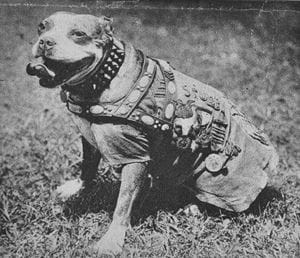
As we observe the 100th anniversary of the end of World War I in 2018, not all of those who bravely serve our country stand upright. There are many “tails” of doggy derring-do by furry veterans worth saluting.
The earliest recorded use of canines in combat was by Alyattes of Lydia, now known as Turkey, against the Cimmerians around 600 B.C. War Dogs were also used extensively by the Egyptians, Greeks and Romans. Attila the Hun even used giant dogs in his campaigns. However, no military around the world has utilized War Dogs as extensively, or as effectively, as the United States.
Dogs have fought alongside American forces in every conflict since the Revolutionary War, but only officially since 1942 during World War II. General George Armstrong Custer loved his dogs and had as many as 40-80 at any given time, many of them accompanying him during his Civil War service.
The most decorated dog in U.S. military history to this day is Sgt. Stubby, who is widely considered the forerunner to today’s military working dog program. His story is well documented in history books, but was largely forgotten until recently when his incredible feats of bravery were captured in the animated film, "Sgt. Stubby: An American Hero."
Stubby, named for his short tail and stature, was a stray rescued by a doughboy on the eve of WWI off the streets of New Haven, Connecticut. Stubby was reportedly permitted to accompany the troops overseas aboard ship because Private First Class Robert Conroy of the 102nd Infantry Regiment, 26th “Yankee” Division taught his furry charge to salute, which amused Army brass.
Sgt. Stubby saw frontline action in France in four offensives and 17 battles. His heroics included finding wounded Soldiers, warning of incoming attacks, saving an entire platoon from a mustard gas attack and even catching a German spy. His brave feats were front-page news. The four-legged hero came home to lead victory parades, appear on Vaudeville stages and meet three sitting presidents.
When he died in 1926 in Conroy’s arms, Sgt. Stubby was memorialized with a more extensive obit in the New York Times than most celebs of the day, and his vest of medals is now part of the National Museum of American History’s collection in Washington, D.C.
Another famous dog with a connection to “The Great War” is Rin Tin Tin, who was rescued by an American Airman following the WWI battle of Saint-Mihiel, in which Stubby’s Yankee Division took part. While Rin Tin Tin was only a hero in the movies, appearing in 27 films, his grandson, Rin Tin Tin III, did his civic duty by officially helping promote the military’s use of dogs during World War II.
On March 13, 1942, following the attack on Pearl Harbor and the entrance of the U.S. into WWII, the U.S. Army began training dogs, launching the War Dog Program or “K-9 Corps.” Initially, civilian dog fanciers garnered military approval to form a coalition called Dogs for Defense, Inc., asking people across the country to donate their pets for sentry training to prevent sabotage. In short order, some 100 dogs were “enlisted” and an ad hoc training program was initiated … with mixed results. On July 16 of that year, the Secretary of War officially assigned responsibility for procuring and training dogs to the Quartermaster Corps, and the stage was set for expansion and formalization of the program.
Since that time, military dogs have saved tens of thousands of lives. Today, the U.S. military’s Working Dog Program has approximately 2,500 dogs in service, with about 700 deployed overseas. While dogs were mostly used as sentries and to deliver messages during the first few conflicts, nowadays they're trained to perform a wide-range of highly-specialized tasks, including sniffing out bombs and drugs and tracking people. Some dogs even jump from planes and rappel from helicopters!
Today, the U.S. military actually has puppy development specialists. The Department of Defense works with carefully-selected puppies from the time they're born until they begin their training at around six to seven months of age. Only about 50 percent of dogs make it through the vigorous training, though some of those who don’t make the cut for high-risk combat missions go to serve in Homeland Security’s Transportation Security Administration (TSA), Border Patrol or police departments. Those not meant for service are adopted and become family pets.
German Shepherds and the heat-resistant Belgian malinois, a breed brought back from the brink of extinction, are military dogs of choice. Doberman pinschers, Belgian sheepdogs, collies, Siberian husky malamutes and Eskimo dogs have also been found to have traits for success.
A fully trained dog may be worth as much as $150,000 depending on their specialty, but the peace of mind they bring to troops is priceless. With an average 98 percent accuracy in their detection skills and noses that are 100,000 times more sensitive than those of humans, it’s estimated that each military work dog saves the lives of about 150 to 200 service members.
Every military working dog is a noncommissioned officer, in tradition at least, always one rank higher than their handler, ensuring that all dogs are respected and well treated.
Most famously, a Belgian malinois war dog named Cairo was an integral part of the elite, 81-member Navy SEALs team that cornered terrorist Osama Bin Laden during a daring raid, Operation Neptune Spear, in 2011. While the identity of the humans on the special ops team are top-secret, Cairo got to meet President Barack Obama stateside.
In January 2013, the Canine Service Member of the Armed Forces Act was signed into legislative law by President Obama, which required the Armed Services to reclassify dogs as recognized military personnel, not “property” to potentially be left behind with equipment, and guarantees canine veterans both medical care and passage home.
Just like human veterans who have seen action, dogs can also suffer from post-traumatic stress disorder (PTSD) and other service-related syndromes or injuries. While many war dogs are adopted by their handlers, earning some well-deserved family time after a life of dedicated service, many, like their human military counterparts, find service in law enforcement after retiring from active duty.
Stateside, the 928th Military Working Dog (MWD) Detachment, assigned to the Connecticut Army National Guard, a full-time unit manned 24/7, is the only military working dog unit in non-active duty as part of the U.S. Army Reserve or National Guard components. It’s only fitting that the National Guard’s only full-time military working dog unit should reside in Sgt. Stubby’s home state.
The 928th’s dogs are trained in explosives detection and tracking, tactical explosive detection and narcotics detection. Among their assignments, the teams have provided military working dog support to 25 presidential missions since the kennel began operations in 2007; patrolled the Boston Marathon in 2014; and supported Pope Benedict's visit to Yankee Stadium in 2008.
Now that’s truly man’s, and woman’s, best friend.

